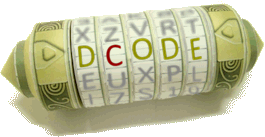Tool to decrypt/encrypt Bacon cipher, a 2-letter substitution alphabet which replace a character with a group of 5 formed with two letters (often A and B).
Bacon Cipher - dCode
Tag(s) : Substitution Cipher
dCode is free and its tools are a valuable help in games, maths, geocaching, puzzles and problems to solve every day!
A suggestion ? a feedback ? a bug ? an idea ? Write to dCode!
Bacon Cipher
Baconian Cipher Decoder
Bacon Encoder
Answers to Questions (FAQ)
What is the Bacon cipher? (Definition)
Bacon's cipher relies on a substitution alphabet using only two letters, usually A and B.
Each letter of the original message is encoded as a combination of five characters composed of these two symbols, according to a system called bilitera or the Baconian alphabet.
To enhance the message's stealth, this coded sequence is often concealed within the plaintext using typographical variations: different writing styles, the use of capital letters or italics, for example.
This method allows the encrypted message to be integrated in a visually discreet manner into seemingly ordinary content.
How to encrypt using Bacon cipher?
Baconian encryption uses the substitution table:
| A | AAAAA | B | AAAAB |
|---|---|---|---|
| C | AAABA | D | AAABB |
| E | AABAA | F | AABAB |
| G | AABBA | H | AABBB |
| I=J | ABAAA | K | ABAAB |
| L | ABABA | M | ABABB |
| N | ABBAA | O | ABBAB |
| P | ABBBA | Q | ABBBB |
| R | BAAAA | S | BAAAB |
| T | BAABA | U=V | BAABB |
| W | BABAA | X | BABAB |
| Y | BABBA | Z | BABBB |
Example: DCODE is encrypted AAABB,AAABA,ABBAB,AAABB,AABAA
In this original alphabet (₂₄), the letter V does not exist, it is replaced by U, likewise the letter J does not exist, it is replaced by I.
Another bacon's alphabet (₂₆) is sometimes preferred, more complete, it uses a unique code for each letter:
| A | AAAAA | B | AAAAB |
|---|---|---|---|
| C | AAABA | D | AAABB |
| E | AABAA | F | AABAB |
| G | AABBA | H | AABBB |
| I | ABAAA | J | ABAAB |
| K | ABABA | L | ABABB |
| M | ABBAA | N | ABBAB |
| O | ABBBA | P | ABBBB |
| Q | BAAAA | R | BAAAB |
| S | BAABA | T | BAABB |
| U | BABAA | V | BABAB |
| W | BABBA | X | BABBB |
| Y | BBAAA | Z | BBAAB |
The 2-letter code used can be hidden in an over-encryption. A classic method is to write a random message with upper case (for A) or lower case (for B) or vice versa. Other methods are possible such as writing certain characters in italics (or in bold), or even mixing 2 fonts.
How to decrypt Bacon cipher?
Baconian decryption is a substitution with Bacon alphabet.
Example: AAABB AAABA ABBAB AAABB AABAA is equivalent to DCODE.
If over-encryption has been applied, convert the message into 2 characters (preferably A and B) first.
How to recognize a Bacon ciphertext?
The ciphered message is a binary code (with 2 distinct characters), and maybe spaces every 5 characters.
Typical cases of over-encryption are alternating upper-lower case letters, bold or italic letters or encoding different character fonts.
All references to Françis Bacon (the painter or the philosopher), Kevin Bacon (actor of Batman), to Novum organum, or to bacon slices (pork, larding, smoked, salted, english breakfast, eggs, etc.) are clues.
The tomb of cryptographer William Friedmans is engraved with a hidden inscription coded with Bacon.
What are the variants of the Bacon cipher?
The letters A and B can be replaced by others characters, such as 0 and 1, to transform the message into binary format.
Sometimes the letters o and l are used: lolol loolo lolol.
The over-encryptions (of the steganographic type) are sometimes used to mask the binary form (upper case, lower case, variant characters or fonts, etc.).
The use of groups of 5 characters may be an indication of a Baconian cipher.
When was Bacon cipher invented?
Francis Bacon first described the Bacon alphabet in 1605 in a letter entitled The Proficience and Advancement of Learning Divine and Humane.
Source code
dCode retains ownership of the "Bacon Cipher" source code. Any algorithm for the "Bacon Cipher" algorithm, applet or snippet or script (converter, solver, encryption / decryption, encoding / decoding, ciphering / deciphering, breaker, translator), or any "Bacon Cipher" functions (calculate, convert, solve, decrypt / encrypt, decipher / cipher, decode / encode, translate) written in any informatic language (Python, Java, PHP, C#, Javascript, Matlab, etc.) or any database download or API access for "Bacon Cipher" or any other element are not public (except explicit open source licence). Same with the download for offline use on PC, mobile, tablet, iPhone or Android app.
Reminder: dCode is an educational and teaching resource, accessible online for free and for everyone.
Cite dCode
The content of the page "Bacon Cipher" and its results may be freely copied and reused, including for commercial purposes, provided that dCode.fr is cited as the source (Creative Commons CC-BY free distribution license).
Exporting the results is free and can be done simply by clicking on the export icons ⤓ (.csv or .txt format) or ⧉ (copy and paste).
To cite dCode.fr on another website, use the link:
In a scientific article or book, the recommended bibliographic citation is: Bacon Cipher on dCode.fr [online website], retrieved on 2025-12-18,
